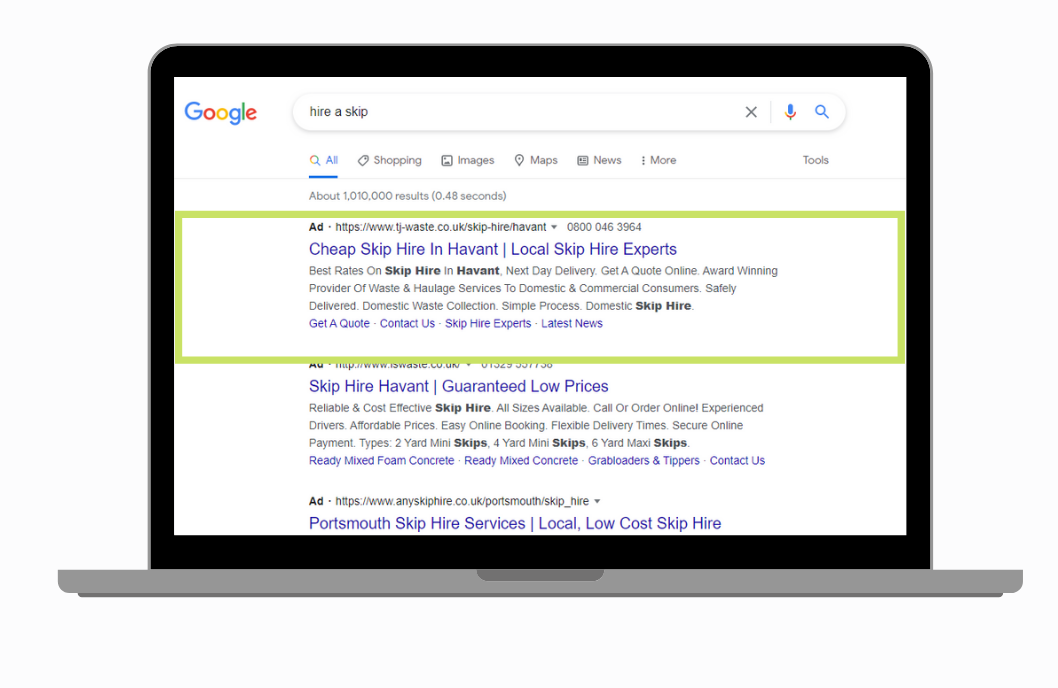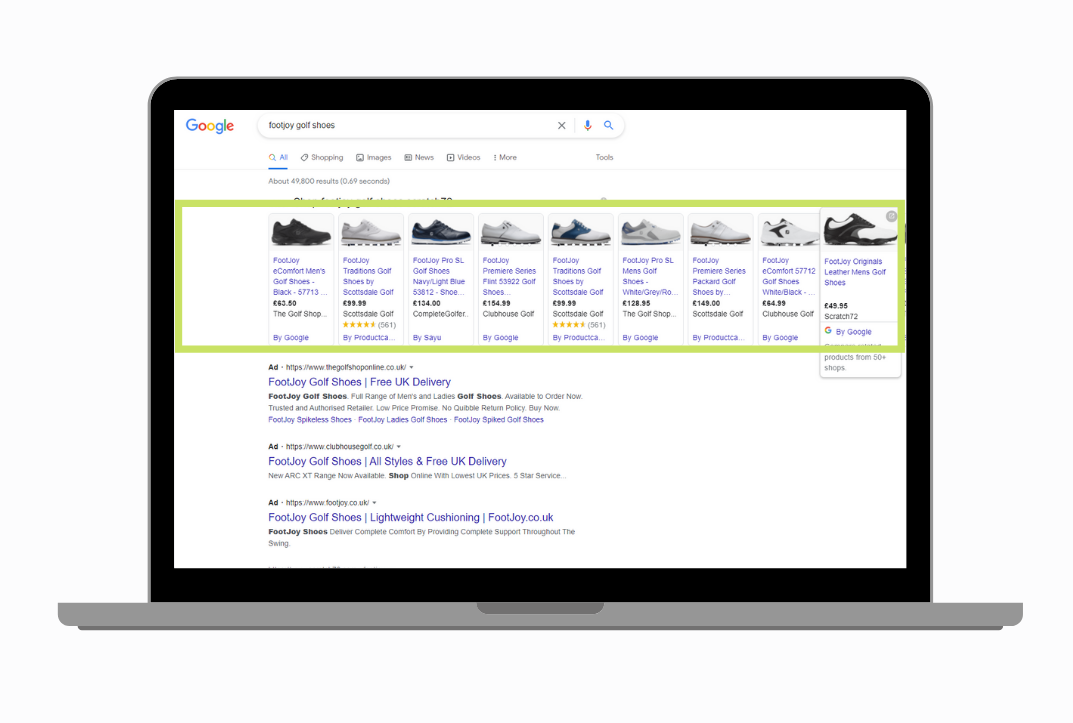How to get on the first page of Google Search

DATE: 16th August 2021
CATEGORY: acquisition
TAGS: search engine optimisation
AUTHOR: Peter Garrett
5 tips for getting on the first page of Google search
Whether you’ve recently moved your business online or just started to notice that your website is pretty hard to find, you might be wondering how to get on the first page of Google.
You may be surprised to learn that there is an entire area of digital marketing that is dedicated to improving the visibility of a website in search results: this is known as Search Engine Optimisation or SEO. SEO is the process of improving a website's performance so that it appears higher in organic search engine results.
It’s no secret that websites that show up on the first page of search engine results pages (SERPS) get more website traffic than those that do not. In fact, 75% of users never scroll past the first page of search results. In simple terms, this means that most businesses should not and cannot afford to skip SEO.

Like it or not, Google and other search engines are an invaluable tool that we use in everyday life. Each day, 3.5 billion searches are made on Google alone. Search engines are generally the first place that the majority of internet users turn to in order to find information, locations and businesses.
As such, a good online presence fuelled by good SEO practices and strategy is key to capturing this traffic, convincing users to visit your website over your competitors and converting those visitors into paying customers.
Claiming a spot on the first page of Google search is no small feat; it takes patience and regular maintenance. SEO is a long term investment but the returns are well worth the time invested. For those that want to get on that first page and drive organic traffic, here are 5 steps you can take:
1. Perfect your user experience
Each of Google’s most recent core algorithm updates relate to humans and their experience with search engines. For example, the recent focus on Core Web Vitals is centred around the user experience and making your website better for users. The ‘Helpful Content’ update aims to provide users with content that adds value and satisfies their expectations.
This tells us that Google values users above all else. Therefore, providing a good user experience is key to ranking well in search engines. Most SEO practices converge on the central goal of improving users’ online experience and making it easier to find, navigate and engage with content. This could include:
-
Creating content centred around user intent (more on that later)
-
Improving page load times to ensure swift and seamless navigation
-
Ensuring your website is mobile friendly as more than half of website traffic worldwide comes from mobile
-
Structuring content so that it is logical and easy to scan with appropriate use of heading tags
-
Providing descriptive alt text to images which improves accessibility
We could go on but ultimately, creating a seamless user experience for users is crucial to creating an experience that people want to share with others. It should always be an essential component of your SEO strategy.
2. Set up and optimise your Google My Business profile
Google My Business essentially allows you to set up a business profile for free which can then appear, at least locally, on Google Search and Google Maps when users search for your business. Within your profile, you can add all-important information about your business including:
-
Overview of business
-
Address (if you have one)
-
Photos
-
Share offers and updates
-
Answer questions
A Google My Business listing is beneficial for SEO because it helps customers discover your business and tells them where you are located and how to buy from you. Within the listing, customers can leave reviews which builds social proof and proves to other potential customers that you’re a legitimate business. As an example, here’s our Google My Business listing in Google Search:
BONUS TIP
Set up a business profile on Bing Places for business and Apple Business Connect to maximise the chances of your business appearing on Bing and Apple Maps.
3. Create valuable content
Updating your website content regularly is key to better rankings. This isn’t limited to only adding fresh and new content, though this is one way. Repurposing and overhauling old content can be just as effective. This is because original content becomes less relevant over time and freshness of content is one of the factors that Google uses to determine your website’s quality and ranking.
If you are leveraging AI tools to automate the content creation process, be wary of plagiarism and content that lacks value. While AI can speed up the writing process, it's essential to critically monitor the output to ensure originality and maintain a high standard of quality. Plagiarism can not only harm your website’s credibility but also it has a negative impact on your search engine rankings.
BONUS TIP
Evaluate your content against Google’s helpful content guidelines to make sure you are creating content that is useful and valuable.
Another thing you could do is to research your competitors' top performing content and make it better. If you've already published an article covering a similar topic but find that your competitors are outperforming you in rankings, take a closer look at what elements are present in their content that might be lacking in yours. By constantly refining and improving your content based on competitor analysis, you position yourself not only to catch up but to set a new standard in your niche. This proactive approach ensures that your audience receives the most valuable and up-to-date information, solidifying your authority in the field.
What is search intent?
When creating content, it is vital to align with and really address a user’s search intent. Search intent refers to what a user really wants when they type a query into a search engine. This usually falls into four categories:
-
Informational: Occurs when a user wants to learn more information. E.g. ‘laptop’
-
Navigational: Occurs when a user is looking for a specific website or destination. E.g. ‘Facebook’ or ‘YouTube’
-
Commercial: Occurs when a user is close to purchasing but is researching which solution is right for them. E.g. ‘HP vs Dell Laptop’
-
Transactional: Occurs when a user is searching with a specific outcome in mind. E.g. ‘HP Pavilion 15-eh0017na Laptop’
As you can see, the broader the search term, the further away we are from being ready to purchase. Our search queries tend to get more specific as purchase intent increases. With this in mind, it’s important to craft your content to match the user's end goal otherwise you’ll struggle to rank well.
BONUS TIP
If you aren’t sure of the intent behind a search query, try using Semrush’s keyword tool which provides data on the implied intent of users.
4. Earn and build high-quality links
In SEO, a backlink is a link from one website to another. They are a fundamental component of the internet as they are used by search engines, like Google, to discover new content. Links are one of the most significant signals used by Google and other search engines to determine a website’s quality and relevance. High quality links are like votes of confidence in your website. Therefore, backlinks play a crucial role in search engine optimisation.
Link building is the process of acquiring inbound links from other websites linking to your website. In simple terms, more links to your website signals to Google that you are an authoritative source and you’ll be rewarded with better rankings on search engines. This should then result in more traffic.
There are many in depth guides across the internet that teach you how to build links, but here are a few techniques:
-
Create high quality content that people naturally want to link to
-
Give a testimonial
-
Provide an expert opinion
-
Guest posting on relevant external blogs
-
Set up Google Alerts for brand mentions and ask for a backlink
-
Find broken links and suggest replacing a broken link with relevant content on your site
5. Use social media to your advantage
Integrating Social media into your business and SEO strategy is essential to remain competitive. The landscape of search engine optimisation has evolved, and search engines now reward social signals such as shares and likes. Engagement plays a pivotal role in organically boosting your website traffic.
While links from social media platforms may not directly impact search engine rankings, an active social media presence supports your SEO efforts in other ways. This is because it helps to build authority and credibility. Generally with social media algorithms, more engagement means more visibility which boosts brand awareness. When you post valuable and unique content to your social media that naturally attracts engagement, this usually results in an increase in followers, website traffic and a growth in community around your brand.
This positive cycle of engagement, visibility, and community growth further reinforces your brand's online presence and contributes to the overall success of your digital strategy.
SEO takes time
While implementing the strategies outlined above, it's crucial to understand that SEO is a long-term game. Immediate, substantial results should not be anticipated within days. instead, it's common for significant improvements to manifest over the course of several months.
Patience and consistency is key in this process, so resist the temptation to abandon your efforts prematurely. Commit to the journey, as consistent and persistent SEO practices are the foundation for sustainable success.
If you want to gain more visibility in search results, please get in touch.
There is one more thing you can do to get on the first page…
Google Ads
If time is of the essence and you want to get on the first page of Google search quickly, you could try Google Ads. Google Ads are a quick way of getting visibility on the first page of Google within as little as a few hours.
Google Ads sit at the top of Google search results above organic listings and are the first thing that a user sees when they make a search. Within search results, there are two different types of ads that are shown:
1. Google Search Ads
Google Search Ads are shown to people actively searching for keywords related to your product, service or business. Search campaigns are highly targeted because users that come across your search ads are already searching for your product or service. This makes search campaigns a great choice for any business that wants to generate more sales, leads or website traffic.

2. Google Shopping Ads
Google Shopping Ads are highly visual ads that appear at the top or the side of search results when a user searches for certain products. Leads that click on shopping ads tend to be better qualified because these ads always show a picture of your product, title, price and shop name which gives users a strong sense of the product beforehand. Shopping ads are the perfect choice for ecommerce stores that want to promote their products.

In summary...
Google Ads are an excellent choice for any business that wants to get on the first page of Google and gain more visibility quickly. However, they do require significant work for both initial setup and ongoing maintenance to ensure that you’re getting a good return on investment.
Thinking about using Google Ads but not sure where to start? Please get in touch to discuss your needs.
« All blogs